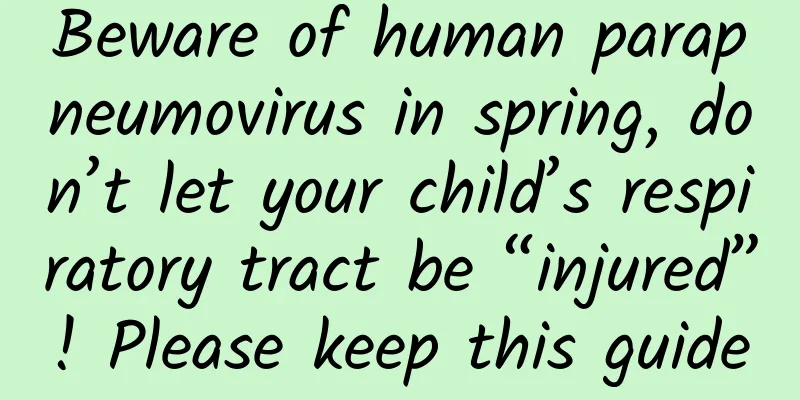Beware of human parapneumovirus in spring, don’t let your child’s respiratory tract be “injured”! Please keep this guide

|
With the arrival of early spring, human metapneumovirus (MPV) infection has become one of the common "culprits" of respiratory diseases in children. As a parent, it is crucial to understand the transmission route, symptoms, diagnosis methods and prevention measures of this virus in order to protect the health of your children. Human metapneumovirus1. What is human metapneumovirus? Human metapneumovirus is a common respiratory virus that, like respiratory syncytial virus (RSV), can easily cause respiratory infections in children. Although it was only officially named in 2001, this virus has actually been circulating in the human population for at least 60 years. Today, human metapneumovirus is widely prevalent worldwide and has been identified as an important pathogen of acute respiratory infections in children and adults, posing a major health threat to the elderly and immunocompromised populations. 2. Which groups of people are susceptible to human metapneumovirus infection? Epidemiological studies have shown that human metapneumovirus is one of the most common pathogens of respiratory infections after respiratory syncytial virus and influenza virus. Human metapneumovirus infection can occur year-round, with higher incidence in late winter and spring. People of all ages can be infected, but the following groups are at greater risk: children under 5 years old, the elderly, and people with weakened immune systems. 3. What are the symptoms after infection? The incubation period of human metapneumovirus is usually 3-6 days. Symptoms include upper respiratory tract infection, such as fever, cough, nasal congestion, runny nose, hoarseness, etc., which gradually improve in about a week. Severe cases may develop bronchiolitis, severe pneumonia and ARDS. The infection may aggravate the condition of COPD patients and induce acute attacks in bronchial asthma patients. Severe lower respiratory tract infections are more common in young children, the elderly, etc. People with weakened immune systems, such as those who have received lung transplants or hematopoietic stem cell transplants, have more severe symptoms after infection, and their mortality rate is relatively high. 4. How to diagnose infection? If a child has respiratory symptoms, the doctor will make a diagnosis in the following ways: Scrape the nasopharyngeal secretions with a throat swab for viral nucleic acid testing, which is currently the most accurate testing method and can quickly detect human metapneumovirus. The Xiangdong Hospital affiliated to Hunan Normal University can perform human metapneumovirus testing. 5. How does the virus spread? The main transmission routes of human metapneumovirus are: It is mainly transmitted through droplets and close contact, and can also be transmitted indirectly through contact with objects contaminated by the virus. 6. How to treat infection After human metapneumovirus infection, the body cannot produce lasting immune protection and is prone to repeated infection. However, there are currently no vaccines or specific antiviral drugs on the market. Treatment mainly focuses on supportive symptom relief, including: ensuring that the child consumes adequate water and nutrition, and using antipyretics when necessary. If pneumonia develops or breathing difficulties occur, hospitalization is required and nebulization, fluid infusion, cough and expectorant treatment are given according to the condition. Severe pneumonia requires oxygen therapy or even ventilator-assisted ventilation. In addition, human metapneumovirus is prone to bacterial infection. If bacterial infection is present, the doctor may prescribe antibiotics for treatment. Although severe human metapneumovirus infection can lead to severe pneumonia, complications other than the lungs caused by viral infection are rare, and the overall prognosis is good. 7. How to prevent human metapneumovirus infection The following measures can effectively reduce the spread of human metapneumovirus and protect your child’s health: (1) Maintain good hygiene habits Wash your hands frequently: especially after touching public objects. Wear a mask: especially in confined spaces or crowded places. (2) Enhance immunity Maintain a regular schedule: adequate sleep helps boost immunity. Balanced nutrition: Eat more foods rich in vitamins and minerals. Moderate exercise: strengthen physical fitness and improve resistance. (3) Pay attention to environmental and personal hygiene Keep ventilation: Open windows regularly to maintain indoor air circulation. Disinfection: Regularly disinfect frequently touched surfaces. Reduce gatherings: Try to avoid going to crowded places, especially children and the elderly. (4) Seek medical treatment promptly If your child's symptoms get worse or he or she has trouble breathing, get medical help right away. Human metapneumovirus infection is one of the important causes of respiratory diseases in children, but by understanding its transmission route, symptoms and prevention measures, we can effectively protect the health of children. As parents, being vigilant, taking preventive measures, and seeking medical treatment in time when children show symptoms are the key to protecting their children's health.
(Edited by YT) |
<<: Can vegetable drinks really help you lose weight and detoxify? Here comes the truth
>>: One in four Chinese people has this "little trouble" hidden in their body.
Recommend
The role of gynecological red light therapy device
Gynecological diseases may cause excessive vagina...
What to do when you have eczema on your face during pregnancy
Pregnant friends also need to pay attention to ma...
My aunt's blood is black
Menstruation is a normal physiological phenomenon...
Pregnancy after ovulation
The lower body of a normal adult woman will secre...
Why do girls feel hot down there?
If girls often feel hot down there, it may be due...
Why do you feel depressed after getting into a good university? Empty-heartedness, are college students doing well?
Author: Kevin Xu, Associate Professor of Peking U...
What foods should you eat to replenish qi and blood after giving birth? Blood-nourishing diet
Giving birth will consume a lot of physical energ...
What causes uterine inflammation? Here to tell you
Uterine inflammation is a common gynecological di...
What is 4b ultrasound monitoring of follicle development?
What is B-ultrasound monitoring of follicle devel...
What to do if there is blood in the vaginal discharge after defecation
The appearance of bloody leucorrhea after defecat...
Can babies use sunscreen?
Not really First of all, babies have tender skin ...
How many days after the period ends do you ovulate?
When women are in their ovulation period, there a...
What is the difference between adnexal cysts and ovarian cysts?
Both adnexitis and ovarian cysts belong to gyneco...
How serious is candidal vaginitis?
Vaginitis candidiasis is a common type of vaginit...
What does breast category 1 mean?
The Birads classification is a classification sys...









